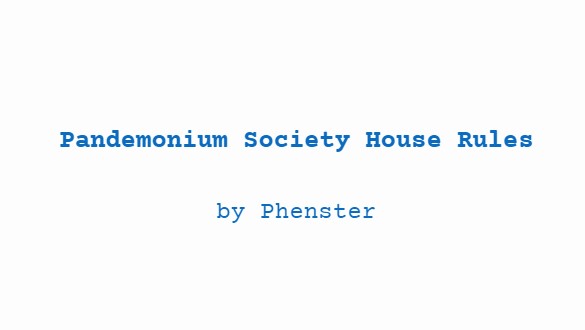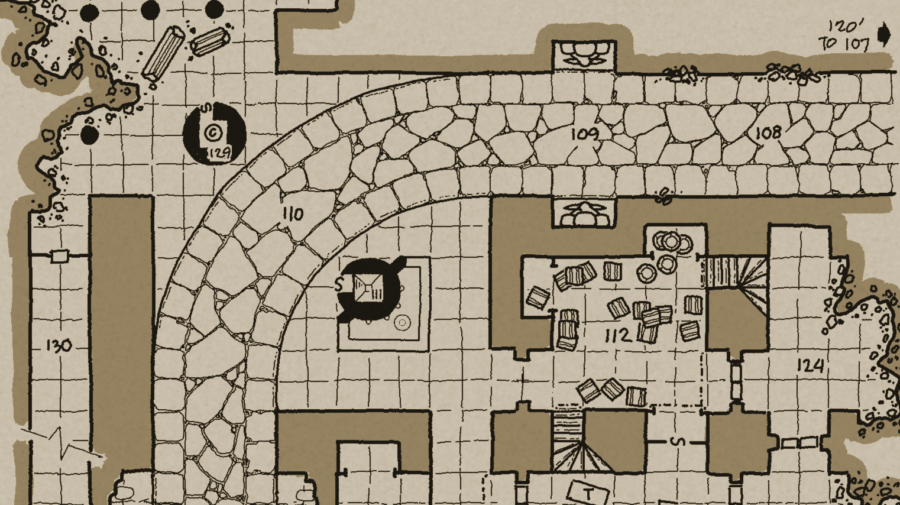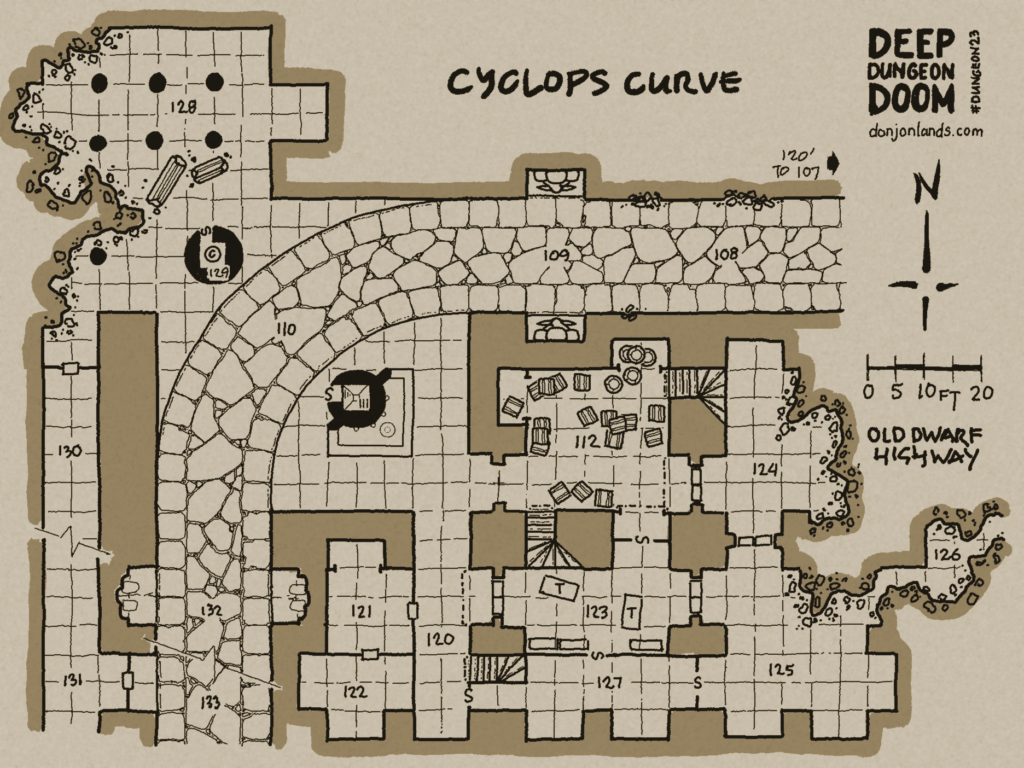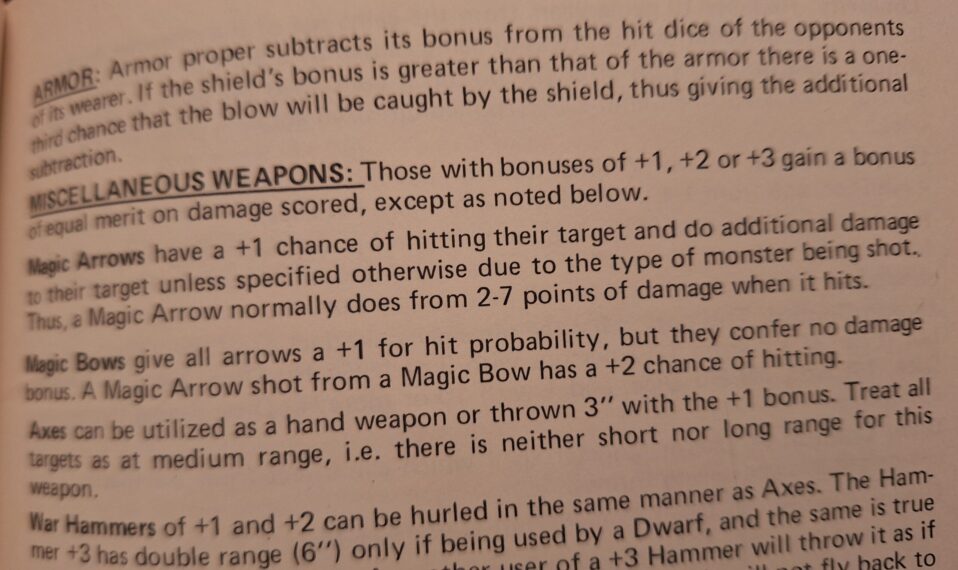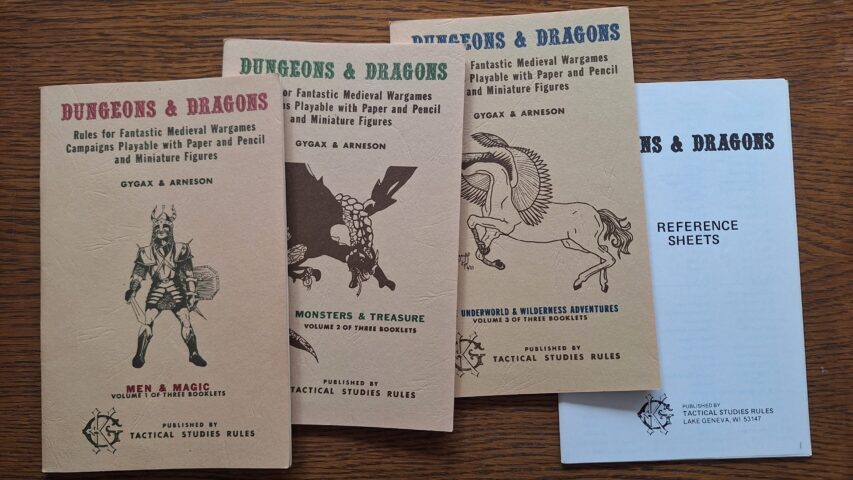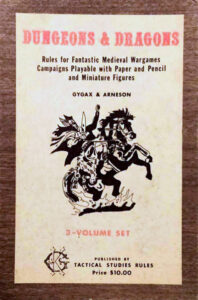Monsters in Deep Dungeons
This is the 35th in a continuing series of articles, which reedits house rules for Holmes Basic D&D from 40-year-old game club newsletters. Mentions of house rules are in bold text and followed by a [bracketed category designator].
For rules category descriptions and more about the newsletters, see “About the Reedition of Phenster’s.” For an index of articles, see Coming Up in “Pandemonium Society House Rules.”
Phenster’s Pandemonium Society House Rules is a work of fiction. Names, characters, businesses, events, incidents, and newsletters are either products of the author’s imagination or are used in a fictitious manner. Any resemblance to actual persons, living or dead, or actual events is pure coincidence.

The 1977 edition of Gygax and Arneson’s DUNGEONS & DRAGONS is also known as “Holmes Basic” after editor Dr. J. Eric Holmes.
In his contribution to the April 1984 issue of L’avant garde, Phenster describes several monsters to challenge higher-level PCs. As with his earlier monster descriptions, I see no need to tamper with the text, and the stats are sound. Moreover, the monsters are not out of the realm of fantasy, so I put the ensemble in category [E] Extra.
I make a couple notes within the text [in brackets]. Otherwise, any holes Phenster leaves the DM may fill to suit.
Apart from the opening reference to AD&D, Phenster makes no mention of any source material. I add footnotes where I am aware of possible sources. Of the monsters given, Baazmaeg, grimpshee, slink, and Demon of the Lake appear to be entirely made up.
Monsters in Deep Dungeons
The rulebook doesn't have very many high-level monsters. AD&D has lots more and that's where we get most of them. But sometimes we make up new monsters too. I'll describe some of them for you. But first, Hazard made a new table for monster HD wandering in the deeper levels of the dungeon, and he added more HD to the XP table.
Wandering Monster Level Matrix
| Monster Level | |||||||||||||||
|---|---|---|---|---|---|---|---|---|---|---|---|---|---|---|---|
| Dungeon Level | 1 | 2 | 3 | 4 | 5 | 6 | 7 | 8 | 9 | ||||||
| 1st | 1-8 | 9-11 | 12 | ||||||||||||
| 2nd | 1-3 | 4-8 | 9-11 | 12 | |||||||||||
| 3rd | 1 | 2-4 | 5-8 | 9-11 | 12 | ||||||||||
| 4th-5th | 1 | 2-4 | 5-6 | 7-8 | 9-11 | 12 | |||||||||
| 6th-7th | 1 | 2-4 | 5-6 | 7-8 | 9-11 | 12 | |||||||||
| 8th-9th | 1 | 2-4 | 5-6 | 7-8 | 9-11 | 12 | |||||||||
| 10th-12th | 1 | 2-4 | 5-6 | 7-8 | 9-12 | ||||||||||
| 13th-15th | 1 | 2-4 | 5-6 | 7-12 | |||||||||||
| 16th+ | 1 | 2-4 | 5-12 | ||||||||||||
XP for Monsters Overcome
| Monster HD | Value | Exceptional |
|---|---|---|
| Under 1 | 5 | 1 |
| 1 | 10 | 3 |
| 2 | 20 | 5 |
| 3 | 35 | 15 |
| 4 | 75 | 50 |
| 5 | 175 | 125 |
| 6 | 300 | 225 |
| 7 | 450 | 375 |
| 8 | 625 | 525 |
| 9 to 10 | 825 | 675 |
| 11 to 12 | 1075 | 825 |
| 13 to 14 | 1375 | 975 |
| 15 to 16 | 1725 | 1175 |
| 17 to 20 | 2150 | 1525 |
| 21 and up | 2650 | 2025 |
| Any pluses to HD make the monster the next higher HD. | ||
MONSTERS
Witches/Warlocks[1]:
Witches (and warlocks) use witchcraft, which is a kind of magic that gets its power from demons and devils. It's also called black magic. Witches sell their soul to a demon or a devil. They have to sign a contract with their own blood, and the demon or devil gives them spells, special powers and rituals. They have 1 witchcraft power for every level, plus they get magic-user and cleric spells.
Witches are notoriously hard to kill. They have regular d8s for HD, and they heal quickly. They start every day and every night with full hit points. Even after you kill them, you have to burn the body and throw the ashes in a running stream, or they might come back, and then they'll be after you.
There are Low Order witches and High Order witches. Low Order witches are the most common ones, and there are a lot of different Low Orders with names like the Coven Under Gnarled Grove, the Gray Raven Coven, and the Evil Eye. Low Order witches can have up to 7 HD. They get magic-user and cleric spells for each level and one witchcraft power per level from the Low Order list. [For spells, treat as cleric/magic-user, both classes of level equal to hit dice.]
The more powerful witches are from the High Order. The only High Order we know about is the Sordid Coven of Greater Malevolence. They lair in a great cavern on the 8th level of the dungeon, where they made a twisted grove of undead trees with colored glass beads and precious gemstones hanging from the branches. High Order witches go up to 13 hit dice (Hazard says, "As far as you know . . ."). For each HD above 7 they get a witchcraft power from the High Order list.
We've heard of another group of witches that has a lair even deeper in the dungeon. They are so secretive that we're not sure what their name is. We just call them "the Dark Covenant." We think it was them who opened the gate that let out a hoard of rampaging demons. They are devious!
Witchcraft Powers
Witchcraft powers aren't spells. Witches can use their powers whenever they want. They don't have to memorize them or forget them. And they don't write them down either. Because they get their powers from their infernal patrons.
Low Order: bewitch (charm), herbal medicine (heal/cause wounds), herbal medicine (poison), permanent familiar, change self (illusion), darkness, hold person, hold portal, fairie fire, speak in tongues, call animal (attack/messenger).
High Order: brew potion (love), brew potion (truth), brew potion (insanity), effigy (control), effigy (injure), change shape, protection from normal missiles, ESP, dark sight.
Witchcraft Rituals
Any two or more witches (High or Low Order, but always from the same coven) can perform a ritual. The more witches participating in the ritual, the more effective it is (e.g. higher saving throw, more damage, larger area, etc.). To perform a ritual, the witches must make certain sacrifices, usually blood (their own or from an animal). There can be lots of different rituals. Here are some: curse, hallucinatory terrain, plant trap, continual darkness, send to Hell, animate dead, guards and wards, commune with spirit, geas, limited wish, call demon/devil.
Alignment
Most witches are either Lawful Evil or Chaotic Evil, never neutral. The lawful ones have devil patrons and the chaotics have demons. There are neutral magic-user/clerics in the pagan tribes of the First Peoples, but those are not real witches. Sometimes NPCs call them witches, but they're really more like druids.
Good Witches
There are rumors that good witches exist too, but we haven't met any yet. They don't have to sign contracts in blood. They work with angels and saints, who grant their powers, which are different from evil witch powers.
NPC ONLY: We can't play witches like a character class, not even good ones. Hazard says any DM who allows players to be witches is completely nuts!
Grimpshee: Undead spirit of someone captured, taunted and killed by an infernal creature. Some say they are not killed, but they are taken down into the Pit to Hell directly. We aren't sure how they become undead then. But when they turn into a grimpshee, they are disfigured and have a drawn out look of horror on their faces. Only magic weapons can hit them, and when they hit you, they drain a level every time. [A cleric turns a grimpshee as a spectre.]
| Move: 90' | Alignment: chaotic evil |
| HD: 6+2 | Attacks: 1 |
| AC: 3 | Damage: 1-8 |
| Treasure Type: E |
Flamewort[2]: Moss that grows in warm, damp, dark places. It glows in pulsating red and orange like fire. It gives light in a 5' radius but no heat. Also called red dragon's wort, because there is usually one of those in a lair nearby.
Demon of the Lake: Underwater flying demon, like a manta ray. Its "wingspan" is 30 feet wide. Its body is 40 feet long and it has a tail 20 feet long with a serpent head at the end. Strange blotches around its mouth turn into a grotesque human-like head when it attacks. The head's jaws are 2 feet wide with long teeth big as daggers. It bites for 1-10 points of damage. Its tail stings with poison, save or die.
| Move: swim 60', fly 120' | Alignment: chaotic evil |
| HD: 13 | Attacks: bite and tail |
| AC: 4 | Damage: 1-10 |
| Treasure Type: E |
Slink: A creeping monster from another dimension that can practically hide in its own shadow. It sneaks around on large, padded feet, and it wears a red stocking cap. It steals valuable objects (99% chance to Pick Pockets) then slips through its shadow into another dimension. It prefers to carry a bag of holding to put its booty in, but a large sack will do. (If no bag of holding, divide its coin treasure by 10. Maximum 600 coins.) When it's got a lot of booty, it passes the stolen goods to a fence (usually bandits/thieves), who sell it to dungeon traders. Slinks don't like weapons, but they'll steal anything left unattended. So we know, if there's a slink around, no point to search for hidden treasure. And don't set the lantern on the floor!
If you can catch a slink, you can slap its hand and it will drop its booty bag and disappear into its other dimension.
| Move: 90' | Alignment: neutral |
| HD: 2 | Attacks: pick pocket |
| AC: 4 | Damage: 0 |
| Treasure Type: F |
Giants[3]:
The giants have their own kingdom that spreads across half the Heptarchy. There are several fire giant kings that try to rule over the whole Giant Kingdom. Below the kings, there are frost giant jarls, then stone giant thanes and hill giant chiefs. They quarrel with each other at every level, but they only fight a battle when there is a dispute over who rules who. There was only ever one Giant War, and that was thousands of years ago.
The cloud giants and storm giants usually stay above the petty politics of the smaller giants. And all the giants mostly ignore the people and rulers of the Heptarchy who live inside the Giant Kingdom as long as they don't make trouble. Except the hill giants (and sometimes stone giants) which often raid human towns.
Giants keep other monsters as pets in their castle lairs. They can be anything from giant-type animals to fantastic creatures (hydras, griffons, dragons, etc., etc.) When giants go outside their lair, they always carry a giant sack full of gold and throwing rocks: 1-6 x 1,000 g.p. and 3-18 rocks.
Bull of Heaven[4]: There's only one Bull of Heaven. It's the biggest monster anybody ever fought. It gores (1-12), it tramples (2-20), it breathes fire (6-36). It goes on rampages and destroys towns, cities and crops for miles around. If you can find out who the Bull belongs to, you can ask for it and you might get it. It used to belong to an old god named Anu. Ishtar got it from him to sic on Gilgamesh. Poseidon got it from Ishtar, and he gave it to King Minos, but then he took it back because Minos reneged on their deal. Friar Tombs got the Bull from Poseidon, because Beowulf the Bully wanted to fight the toughest monster imaginable. If you want the Bull of Heaven, you just have to ask Friar Tombs for it. Serious inquiries only!
| Move: 150' | Alignment: chaotic |
| HD: 23 | Attacks: 1 |
| AC: -1 | Damage: 1-12 |
| Treasure Type: No treasure |
Baazmaeg (demon)
We first heard about Baazmaeg when Mangus Manes called her "the Duchess." Phenster Prime did some research, and I found out that Baazmeag is the Demon Lady of Torment. She rules one of the planes of Hell, either the 4th or the 8th. Baazmaeg looks like a seductive woman without any hair. Her eyes are like bronze. She has fangs, bat wings, a ridge down her spine and a barbed tail that can sap your strength. We haven't met her yet, so Hazard won't tell us her stats. But I'm betting she's got 155 hit points.
Sandestins[5]: Sandestins are made in vats by powerful wizards (mages or arch-mages). They do the wizard's bidding, usually taking care of things around the wizard's tower when the wizard isn't home. They're only 1' tall and look like tiny, chubby humans with fat fingers and grotesque faces.
A sandestin has the same hit dice (roll h.p. separately with d8s) and intelligence as the wizard who made it, and it is imbued with spells, which means it can use the spells whenever it wants. Just about any imbued spells are possible. Here are some popular ones: comprehend languages, hold portal, mending, message, detect invisibility, ESP, knock, levitate, wizard lock, haste, hold person, plant growth, minor globe of invulnerability, telekinesis.
| Move: 60' | Alignment: as creator |
| HD: as creator | Attacks: 1 |
| AC: 2 | Damage: depends |
| Treasure Type: No treasure |
—L’avant garde #62 (April 1984)
1 In an earlier article, I mention the witch class and give the source articles from Dragon magazine. Hazard may have used any or all of these.
“The Witch” NPC class is detailed in Dragon No. 43 (November 1980). Tucked into that article is another article: “The Real Witch” (8) is an origin piece by Tom Moldvay. Also interesting are two articles: “Witchcraft Supplement for Dungeons & Dragons” (Dragon No. 5, March 1977) and “Another Look at Witches and Witchcraft in D&D” (Dragon No. 20, November 1978). Following the latter, check out the related article “Demonology Made Easy” (No. 20).
2 An Internet search comes up with only a reference to Umbelled flamewort, not a moss but a flower, also known as Phlox divaricata, in Circle of the Seasons (London: Hookham 1828). The plant’s luminous and subterranean qualities must be imagined.
3 Giants’ pets and sacks full of gold and rocks may come from the first printing of Holmes, OD&D Monsters & Treasure, or the AD&D Monster Manual. The three sources put 1 to 6 thousand g.p. in a sack. Only AD&D specifies a number of rocks, limiting it to “a large rock or two” (44).
4 From the Epic of Gilgamesh. We might see more later about the Bull of Heaven.
5 However imperfectly represented here, sandestins come from Jack Vance’s Dying Earth and Lyonesse stories. Only the first book of the latter series was published by 1984.
